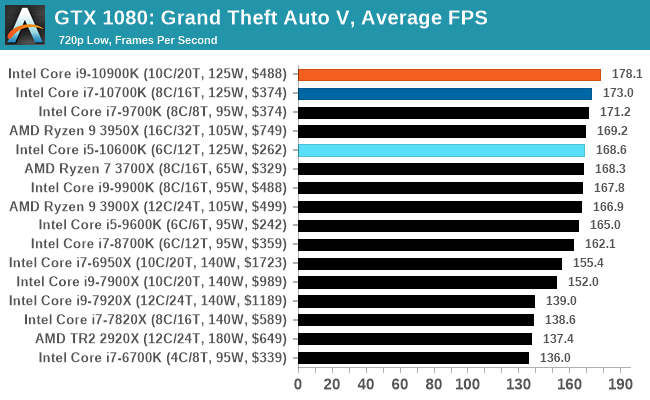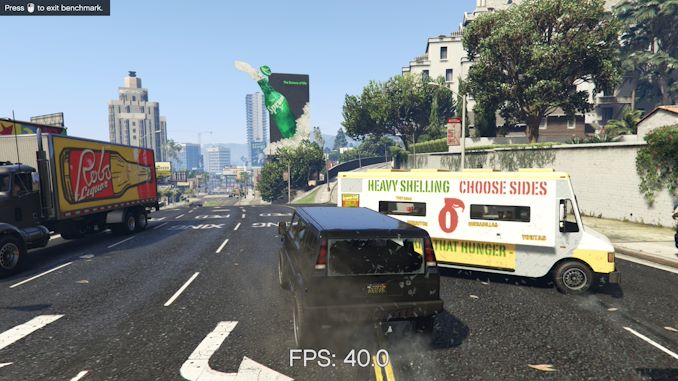The Intel Comet Lake Core i9-10900K, i7-10700K, i5-10600K CPU Review: Skylake We Go Again
by Dr. Ian Cutress on May 20, 2020 9:00 AM EST- Posted in
- CPUs
- Intel
- Skylake
- 14nm
- Z490
- 10th Gen Core
- Comet Lake
Gaming: Grand Theft Auto V
The highly anticipated iteration of the Grand Theft Auto franchise hit the shelves on April 14th 2015, with both AMD and NVIDIA in tow to help optimize the title. GTA doesn’t provide graphical presets, but opens up the options to users and extends the boundaries by pushing even the hardest systems to the limit using Rockstar’s Advanced Game Engine under DirectX 11. Whether the user is flying high in the mountains with long draw distances or dealing with assorted trash in the city, when cranked up to maximum it creates stunning visuals but hard work for both the CPU and the GPU.
For our test we have scripted a version of the in-game benchmark. The in-game benchmark consists of five scenarios: four short panning shots with varying lighting and weather effects, and a fifth action sequence that lasts around 90 seconds. We use only the final part of the benchmark, which combines a flight scene in a jet followed by an inner city drive-by through several intersections followed by ramming a tanker that explodes, causing other cars to explode as well. This is a mix of distance rendering followed by a detailed near-rendering action sequence, and the title thankfully spits out frame time data.
There are no presets for the graphics options on GTA, allowing the user to adjust options such as population density and distance scaling on sliders, but others such as texture/shadow/shader/water quality from Low to Very High. Other options include MSAA, soft shadows, post effects, shadow resolution and extended draw distance options. There is a handy option at the top which shows how much video memory the options are expected to consume, with obvious repercussions if a user requests more video memory than is present on the card (although there’s no obvious indication if you have a low end GPU with lots of GPU memory, like an R7 240 4GB).
All of our benchmark results can also be found in our benchmark engine, Bench.

| AnandTech | IGP | Low |
| Average FPS |  |
 |
| 95th Percentile |  |
 |











220 Comments
View All Comments
SKiT_R31 - Wednesday, May 20, 2020 - link
Intel never left "the top". Top of 720p low graphics settings, by a single percentage margin. Totally worth 50% higher price.silencer12 - Saturday, May 23, 2020 - link
Give it more than 3 yearstracker1 - Wednesday, May 20, 2020 - link
AMD has already shifted their pricing quite a bit from launch in anticipation of this... is it clearly a better option, for most people... unless you literally only care about gaming, then a 10900K or 10700K might be an okay option at their respective price points and only if you're using at least an RTX 2080 Super. If you're going anything lower on GPU, then AMD is probably the better option all the way around (and you'll probably save a bit on your annual power bill as a result).VoraciousGorak - Wednesday, May 20, 2020 - link
Finally, a sane product stack from Intel with regards to naming versus core/thread count.Hifihedgehog - Wednesday, May 20, 2020 - link
Sane and thermal meltdown don't mix.ElvenLemming - Wednesday, May 20, 2020 - link
Unfortunate that their product stack finally makes sense now that the name sounds so stupid I get angry every time I read it.Spunjji - Tuesday, May 26, 2020 - link
Whether it's "Eye-Nine Ten-Nine-Hundred-Kay" or "Eye-Nine Ten-Thousand-Nine-Hundred-Kay", it sounds equally daft.tipoo - Wednesday, May 20, 2020 - link
Chasing clocks and high power to counter AMD. Ah, Netburst, good times. Ish.WaltC - Wednesday, May 20, 2020 - link
I had forgotten Netburst...;) "The Intel CPU that accelerated the Internet"! Thanks for the laugh!trparky - Wednesday, May 20, 2020 - link
Yep, I agree.